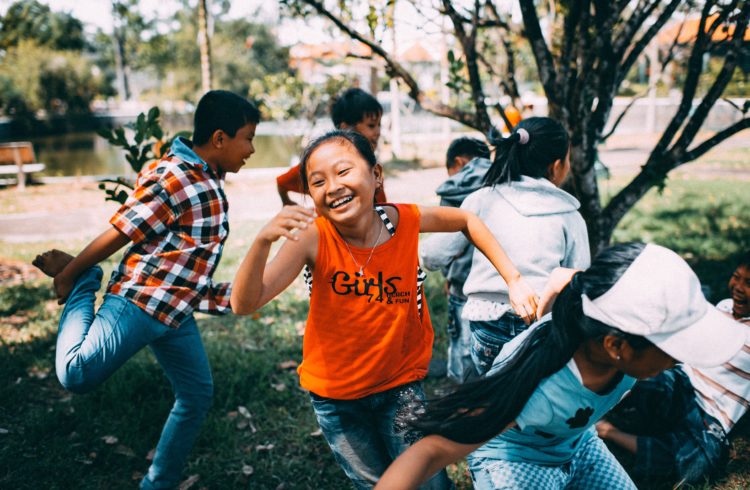Written by Kanthamanee Ladaphongphatthana, INFEMIT and Mahidol University
Religion that God our Father accepts as pure and faultless is this: to look after orphans and widows in their distress and to keep oneself from being polluted by the world (James 1:27).
James 1:27 inspires Christians to take care of vulnerable people, and particularly children who are without provision and protection. Caring for orphans has been one of the “Christian activities” since the 3rd century.1 Indeed, the church has a mandate to serve and love the children so dear to God’s heart.
But how has the church been caring for orphans so far?
It seems a natural response that relatives or family friends would foster and adopt an orphaned child. However, the church in history provided child care differently. Perhaps the need was too great for Christian families to absorb when the church in Byzantine Egypt bought facilities to provide for orphans and widows.1 Perhaps it was more practical for the church to care for unwanted children in large facilities, for what we see is there were church-related almshouses and orphanages in Western society at least up until the 19thcentury.
But in the 20thcentury, the tide turned against caring for children in an institutional setting. After the 1909 White House Conference on the Care of Dependent Children,2 family-based child care grew in popularity. In many Western nations, including the United States and the United Kingdom, foster care became the default form of alternative care for orphans and vulnerable children.
Today, churches actively participate in promotion, recruitment, and support for foster parents in caring for children. The Western church also effectively encourages Christians to provide a permanent home for children in need through adoption.
Then, why are many churches in the West still supporting orphanages in other countries?
Take mine, for example. In Thailand, there are too many orphanages. Apart from public orphanages, there are another 138 registered private children’s homes. On top of that, there are 219 more private orphanages operating in Thailand without license (operating illegally). More than 60% of them are Christian affiliated.3 This high percentage of Christian involvement in child welfare in a predominantly Buddhist country is impressive, given that Christians account for only about 1% of the country’s population.
Missionaries, as well as local Thai churches, provide the main force behind this great number of orphanages. Northern Thailand has the highest density of Christian churches and foreign missions.4 It similarly holds the majority of legal and illegal private children’s homes.3 Some operate with partial support from foreign churches. Some are fully funded or “adopted” by a church in the Western hemisphere.
Orphanages caring for orphans?
The function of orphanages, at least in Thailand, is no longer mainly to care for orphans. Rather, they tend to provide for destitute children and those who lack educational opportunity. This is not all bad, except that the children have to live at the facility—even though around 80% of them have family to return to.5 What we, the global church, may have missed is the fact that orphans and vulnerable children can be provided for and protected at their own homes, as long as it is safe. The church can encourage and strengthen the family to care for their own children instead of funding orphanages where children are at risk of being separated unnecessarily from their families. What we, the global church, may have missed is we can encourage and strengthen families (when it is safe) to care for their own children instead of funding orphanages where children are at risk of being separated unnecessarily from… Click To Tweet
Of course, not all families are loving and nurturing. Children can be at risk of mistreatment, be it purposefully or carelessly, in their families of origin as well as in foster and adoptive families. And yes, there are cases where living at an orphanage is better than remaining in the family. Children’s homes can respond to the physical needs of children better than a poor family. That is why the most common cause for sending children to orphanage is poverty.
Yet, there is something about family that the orphanage cannot replicate. Institutional care facilities where a large group of children are cared for by a few paid staff are detrimental to children. Apart from possible stigmatization, they may cause psychological issues and attachment disorder fueled by orphanage “voluntourism” and short term mission trips. Isolated from their community, children may be deprived of social skills needed to live independently in the future.
The effect of institutionalization is even more damaging for young children. Severe neglect could decrease their brain activity,6 leaving them with lifelong negative impacts. Even a well-meaning orphanage cannot provide each child with the individualized care that they would normally have in their family.
Orphanages still have a place in the continuum of child care. Institutional care has the advantage of capacity to house a large group of children in need, such as in the case of an emergency. Additionally, older children who have already had multiple placements in alternative families may find more certainty by living in a group setting.
But this must be provided professionally and only temporarily.7 The main goal in caring for children should be reintegrating them within their own or alternative families.
What can the global church do?
If we truly believe that the Father of orphans makes homes for the homeless (Psalms 68:5-6), then together we can discern and discuss the best way for the church to provide “home” for orphans and vulnerable children.
In fact, Western churches already provide care for children in family-based environments in their home countries. Why don’t we repeat the same pattern in the mission field in a contextualized way? Instead of funding or creating orphanages, churches can provide family strengthening programs. Rather than having children live in a children’s home to attend school, budget can be paid for related expenses and a school bus. Instead of buildings, the donating church can provide training programs for local churches to serve families in the community. In fact, providing child care in a family and community environment is at least 10 times less expensive than providing child care in orphanages.8 Did you know providing child care in a family and community environment is at least 10 times less expensive than providing child care in orphanages? Click To Tweet
Fortunately, a group of our brothers and sisters are spearheading in this cause. Christian Alliance for Orphans and the World Without Orphans movement raise awareness of these issues among churches globally. The Faith to Action Initiative and ACCI Relief (Kinnected) provide helpful materials readily available for churches to use. Additionally, many other churches and Christian organizations work on holistic child development programs at local levels. Yet, I still hear about new Christian orphanages opening here in Thailand.
The biblical mandate is there. Well-meaning people and funding are ample. The research to help us discern the best interest of the child is within reach. It seems that awareness is the issue here. How can we dialogue and together weigh the pros and cons of our current practices in orphan care? How can we encourage churches to take a stand when it is against our traditional ways of doing ministry abroad?
The answers lie within all of us – the Body of Christ, the Church.
Works cited
- Miller TS. The early history of orphanages: From Constantinople to Venice. In: McKinzie RB, editor. Home away from home: The forgotten history of orphanages. New York: Encounter Books; 2009. p. 23-42.
- Proceedings of the conference on the care of dependent children. Washington D.C.: Government Printing Office; 1909.
- CRC Coalition Thailand. Report of Online Survey to Assess the extent of unregistered Children’s Homes in Thailand. Bangkok: CRC Coalition Thailand; 2016.
- eSTAR Foundation. Christian Presence Map 2018 [Available from: https://thaichurches.org/harvest/mapping/CP/map.html?displaylang=EN&lang=sec.
- Children in Institutions: The Global Picture [Internet]. 2015. Available from: www.wearelumos.org/resources/children-institutions-global-picture/.
- Center on the Developing Child. The Impact of Early Adversity on Child Development (InBrief): Center on the Developing Child, Harvard University; 2007 [Available from: http://developingchild.harvard.edu/resources/inbrief-the-impact-of-early-adversity-on-childrens-development/.
- United Nations. Guidelines for the Alternative Care of Children. UN General Assembly, editor2010.
- Desmond C, Gow J. The Cost-Effectiveness of Six Models of Care for Orphan and Vulnerable Children in South Africa. Durban, South Africa: Health Economics and HIV/AIDS Research Division, University of Natal; 2001.








Missio Alliance Comment Policy
The Missio Alliance Writing Collectives exist as a ministry of writing to resource theological practitioners for mission. From our Leading Voices to our regular Writing Team and those invited to publish with us as Community Voices, we are creating a space for thoughtful engagement of critical issues and questions facing the North American Church in God’s mission. This sort of thoughtful engagement is something that we seek to engender not only in our publishing, but in conversations that unfold as a result in the comment section of our articles.
Unfortunately, because of the relational distance introduced by online communication, “thoughtful engagement” and “comment sections” seldom go hand in hand. At the same time, censorship of comments by those who disagree with points made by authors, whose anger or limited perspective taints their words, or who simply feel the need to express their own opinion on a topic without any meaningful engagement with the article or comment in question can mask an important window into the true state of Christian discourse. As such, Missio Alliance sets forth the following suggestions for those who wish to engage in conversation around our writing:
1. Seek to understand the author’s intent.
If you disagree with something the an author said, consider framing your response as, “I hear you as saying _________. Am I understanding you correctly? If so, here’s why I disagree. _____________.
2. Seek to make your own voice heard.
We deeply desire and value the voice and perspective of our readers. However you may react to an article we publish or a fellow commenter, we encourage you to set forth that reaction is the most constructive way possible. Use your voice and perspective to move conversation forward rather than shut it down.
3. Share your story.
One of our favorite tenants is that “an enemy is someone whose story we haven’t heard.” Very often disagreements and rants are the result of people talking past rather than to one another. Everyone’s perspective is intimately bound up with their own stories – their contexts and experiences. We encourage you to couch your comments in whatever aspect of your own story might help others understand where you are coming from.
In view of those suggestions for shaping conversation on our site and in an effort to curate a hospitable space of open conversation, Missio Alliance may delete comments and/or ban users who show no regard for constructive engagement, especially those whose comments are easily construed as trolling, threatening, or abusive.